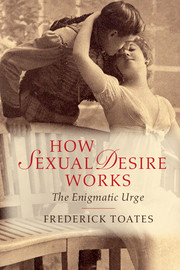Book contents
- Frontmatter
- Dedication
- Contents
- List of figures
- Preface
- One What is enigmatic about sexual desire?
- Two Explaining desire: multiple perspectives
- Three Sexual desire in a broad context
- Four An incentive-based model
- Five Sex and levels of organization
- Six Sexual attraction
- Seven Shades of desire from simple to complex
- Eight Details of the brain and desire
- Nine Arousal
- Ten The consequences of sexual behaviour and associated expectations
- Eleven Sexual familiarity and novelty
- Twelve Inhibition, conflict and temptation
- Thirteen How did sexual desire get here?
- Fourteen Setting the trajectory: link to adult sexuality
- Fifteen Sexual desire in interaction
- Sixteen Representations of sex
- Seventeen Sexual addiction
- Eighteen Variations in desire: general principles
- Nineteen Some forms of desire at the fringes
- Twenty The toxic fusion: violence and sexual desire
- Twenty one Sexually associated (serial) murder
- Twenty two Concluding remarks
- Notes
- References
- Index
Thirteen - How did sexual desire get here?
Published online by Cambridge University Press: 05 October 2014
- Frontmatter
- Dedication
- Contents
- List of figures
- Preface
- One What is enigmatic about sexual desire?
- Two Explaining desire: multiple perspectives
- Three Sexual desire in a broad context
- Four An incentive-based model
- Five Sex and levels of organization
- Six Sexual attraction
- Seven Shades of desire from simple to complex
- Eight Details of the brain and desire
- Nine Arousal
- Ten The consequences of sexual behaviour and associated expectations
- Eleven Sexual familiarity and novelty
- Twelve Inhibition, conflict and temptation
- Thirteen How did sexual desire get here?
- Fourteen Setting the trajectory: link to adult sexuality
- Fifteen Sexual desire in interaction
- Sixteen Representations of sex
- Seventeen Sexual addiction
- Eighteen Variations in desire: general principles
- Nineteen Some forms of desire at the fringes
- Twenty The toxic fusion: violence and sexual desire
- Twenty one Sexually associated (serial) murder
- Twenty two Concluding remarks
- Notes
- References
- Index
Summary
[B]elow the wall, out of sight of their parents but in full view of our porch, their two children, a small boy and girl, were examining each other’s private parts. Someone called my mother’s attention to this, and she sucked in her breath and said, ‘If I caught my boys doing that, I would skin them alive!’
(B. F. Skinner, 1976, p. 60)Looking back in time, what led to an adult’s brain/mind, with its ‘regular’ as well as idiosyncratic features of sexual desire? Considered in this way, the individual has a history in terms of two related aspects:
human evolution, starting millions of years ago;
development of the individual from conception to adulthood.
To understand how desire got here, it can be insightful to look at events happening over these two very different time scales, which is done in this chapter and the next. Such questions arise as:
What are the roles of nature and nurture in determining human sexual desire?
What evolutionary factors contributed to contemporary sexual culture and how did they do so?
How does the early experience of the child lead to the later emergence of sexual desire?
What is the role of interactions between the child and its parents in leading to a brain/mind that finds other humans attractive?
What sort of individual becomes the object of desire and how does this occur?
How can an unusual development lead to unusual sexual behaviour?
The development of sexual behaviour can be best understood in terms of general principles of development, described next.
A broad framework: some general processes underlying development
From conception and starting ‘simply’ as a single fertilized egg cell, the newly formed individual develops and grows, by means of cells dividing and thereby their number multiplying astronomically. The growing foetus interacts with its physical environment, by absorbing nutrients, making limb movements and bodily adjustments. This is believed to facilitate the wiring of the motor controls of the body, in forming coordination between brain and muscles.
- Type
- Chapter
- Information
- How Sexual Desire WorksThe Enigmatic Urge, pp. 229 - 244Publisher: Cambridge University PressPrint publication year: 2014



